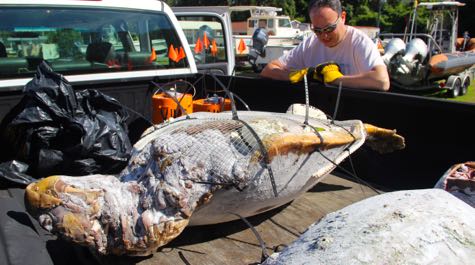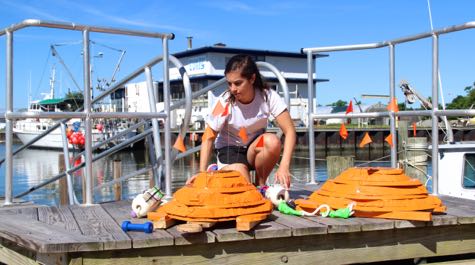It was a dark and stormy night in the laboratory
“Frankenturtles” help to reduce sea turtle mortality
We’ve all heard the classic tale of Dr. Frankenstein and his makeshift monster, but few realize similar experimentation is taking place at William & Mary’s Virginia Institute of Marine Science (well, kind of).
While the scene is actually on the sunny banks of Chesapeake Bay rather than a dark laboratory with jagged bolts of lightening illuminating the night sky, researchers are investigating where hundreds of dead loggerhead sea turtles that wash up on Chesapeake Bay beaches each summer are perishing. Their approach to finding a solution to this problem is ingenious if not somewhat morbid.
Comprised of one graduate student and a professor, the research team started by stitching lifeless sea turtles back together and releasing them into the Bay. One of the Frankenturtles used for the study was created using the remains of a 15-20 year old loggerhead killed by a boat strike. The other is a younger turtle whose death remains a mystery.
By deploying the turtle carcasses and comparing them with other drifters, then comparing that data with historical records of stranding locations provided by the Virginia Aquarium’s Stranding Response Team, the researchers should be able to backtrack from a stranding site to the place where the turtle likely died.
When it comes to deploying the Frankenturtles, it’s not as simple as you may think. In addition to the unforgettable and growing aroma of thawing turtle, the creatures are both heavy and awkward. The larger Frankenturtle weighs in at 150 pounds, the smaller at 70 pounds.
By figuring out the ‘where,’ the researchers will be able to better look at the ‘why.’
Potential sources of mortality in the Bay include accidental capture in fishing gear, strikes by boat propellers, entanglement in plastic trash and sudden drops in temperature.
Once the researchers are able to pinpoint the where and why, wildlife authorities will be able to map out safe zones for these imperiled marine reptiles.
















